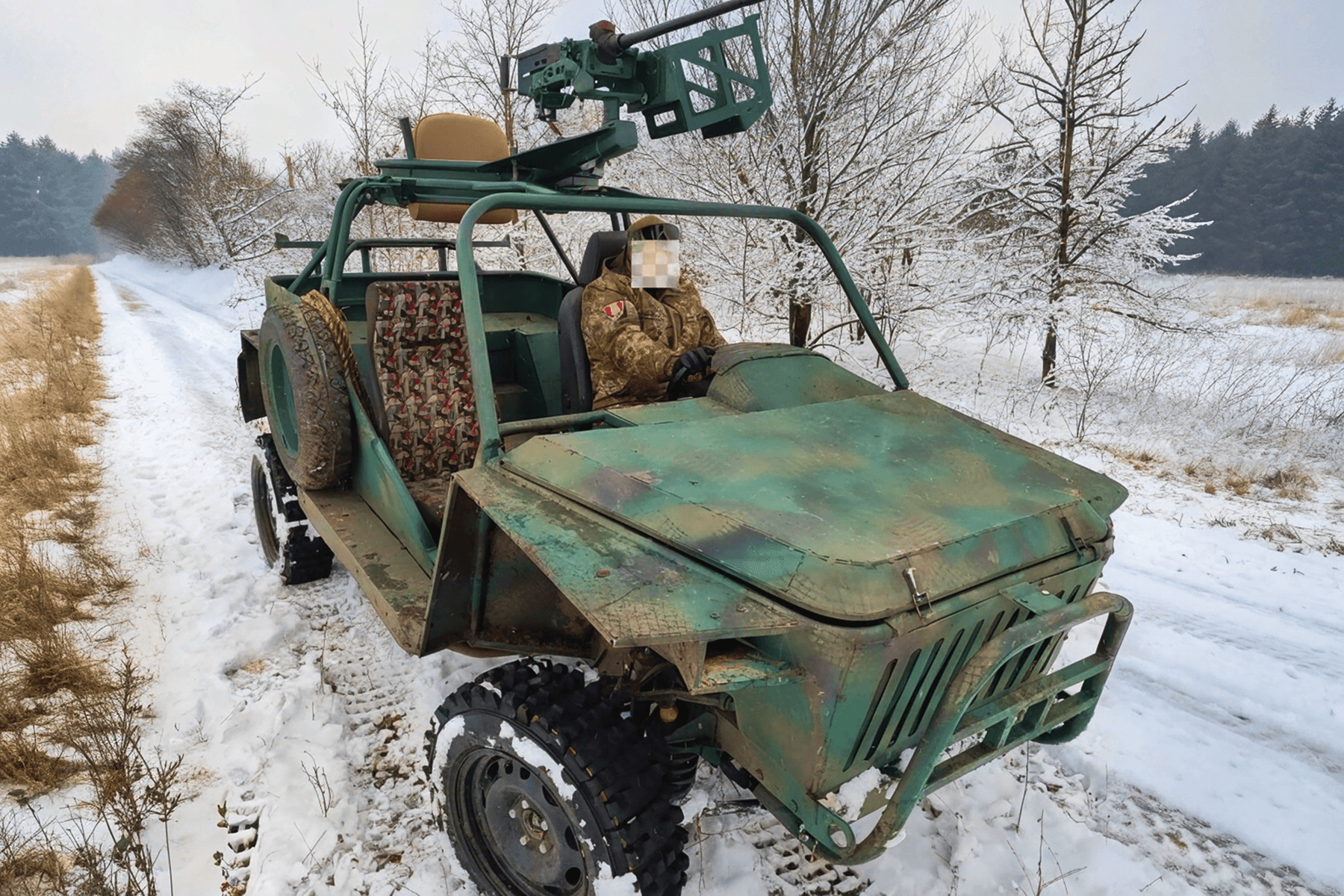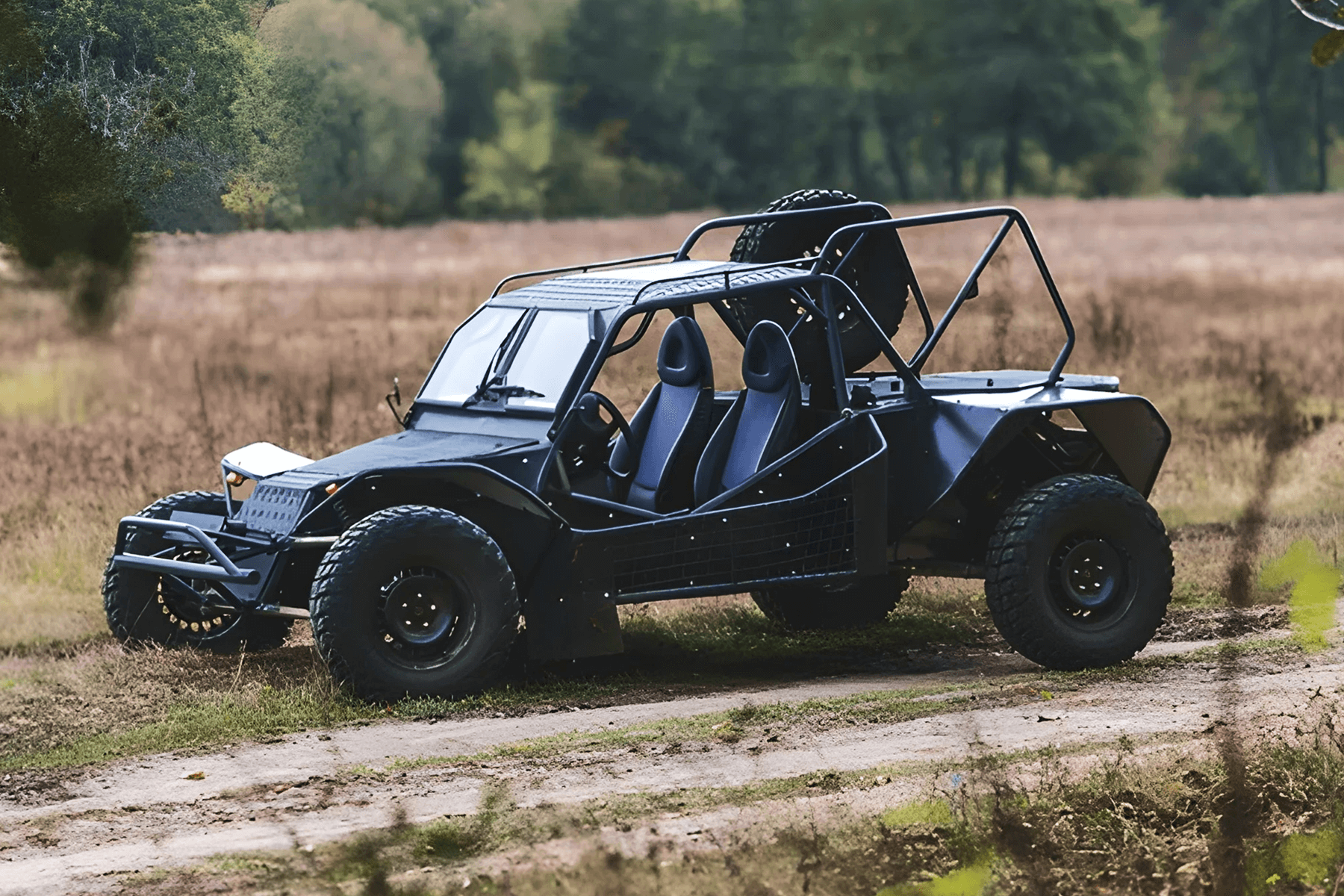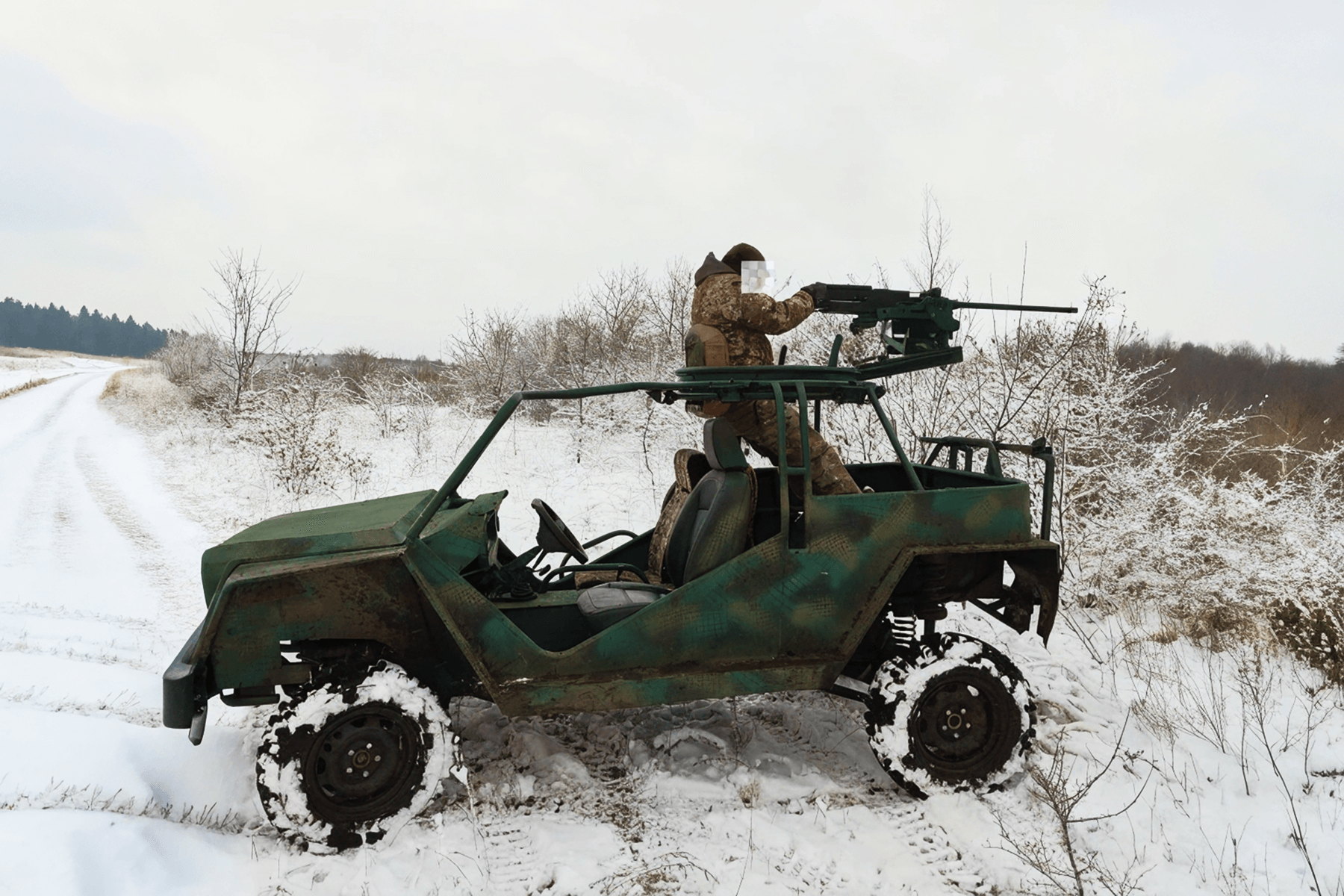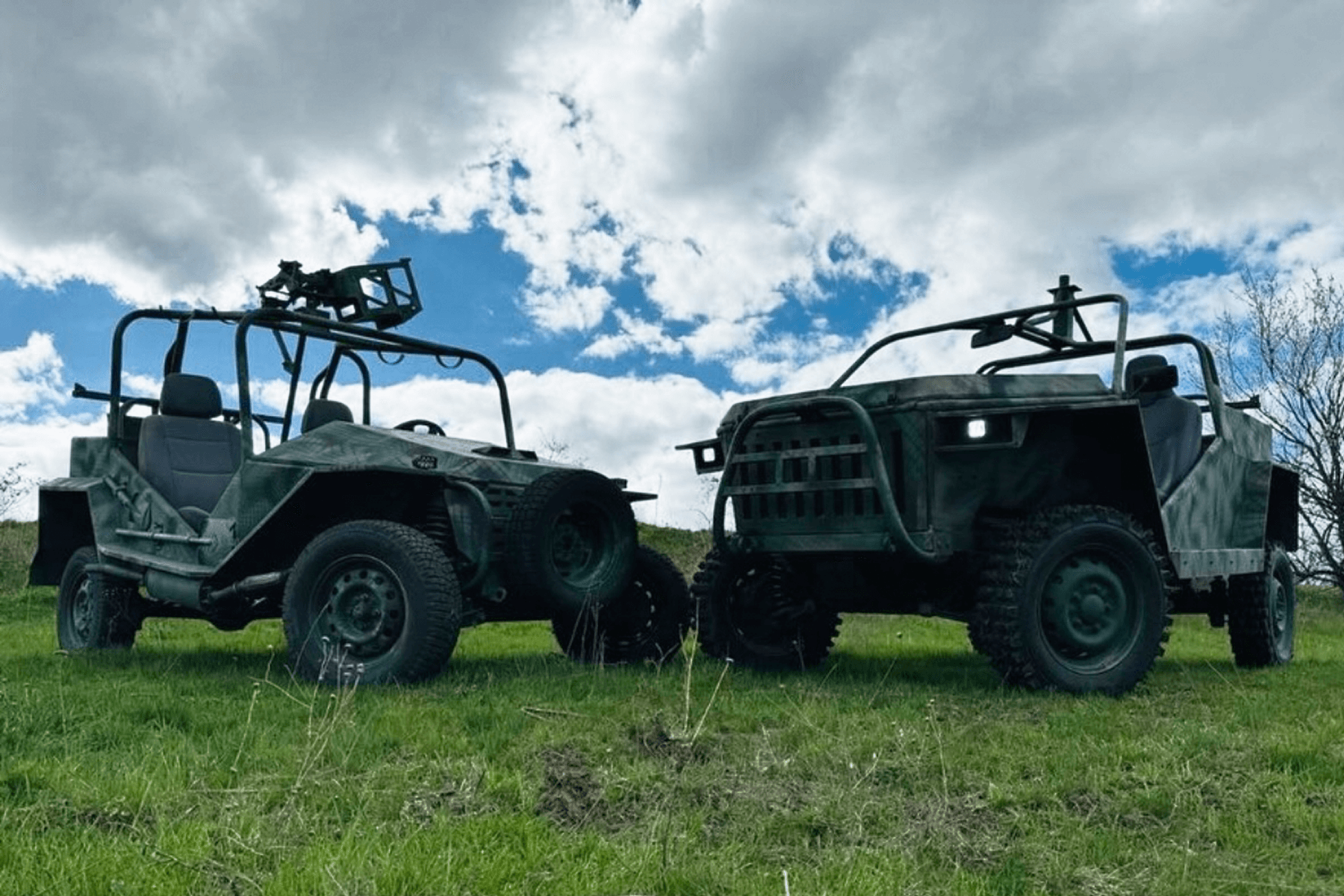In modern warfare, survival often depends not only on weaponry, but also on how quickly and safely soldiers can reach positions, evacuate the wounded or deliver ammunition. That is why light tactical vehicles — buggies — are becoming increasingly common on the front line.
Manoeuvrable, fast and compact, they are capable of carrying out tasks beyond the capabilities of heavy equipment. While such vehicles were initially a volunteer initiative, Ukraine now has full-fledged production of combat buggies.

What are buggies and where did they first appear?
The first buggies appeared in the US in the 1950s. They were made from old Volkswagen Beetle (Volkswagen Bug) cars, and the word “buggy” — a diminutive of “bug” — became the name for the lightweight off-road vehicles.
The body, doors and wings were removed and either a lighter frame or a fibreglass body was installed. Thanks to its sturdy chassis, rear-mounted engine and lack of a radiator, the Beetle was ideal for this kind of tuning.
In global practice, buggies were first used on a large scale during Operation Desert Storm in 1990-91. American and British forces employed them for rapid movement across difficult off-road conditions. During that operation, buggies were the first vehicles to cross into Kuwait, moving off-road.
Today, buggies are in service with the world’s most powerful armies, including those of the United States, the United Kingdom, Israel, France and other NATO countries. For example, the US has more than 20 different models of buggies in service, and this is no coincidence. Military conflicts in Afghanistan and Iraq have proven their effectiveness in carrying out special missions, especially in conditions where the use of heavy armoured vehicles is impractical.
Since the beginning of the Russian aggression in 2014, and especially after the full-scale invasion in 2022, the need of Ukraine’s armed forces for manoeuvrable tactical vehicles has increased significantly. Ukraine’s military has learned that in the conditions of modern warfare, with the active use of drones and artillery, mobility, compactness and speed of response often become decisive factors for survival on the battlefield.
The history of buggies in the Ukrainian army
The first Ukrainian military buggies appeared in 2014, when it became clear that effective resistance to the enemy would require unconventional solutions. At that time, Ukrainian inventors and enthusiasts began developing the first prototypes of domestic buggies.
In 2015, using funds raised by volunteers, Yuriy Berko, an entrepreneur, inventor and racing driver from Vinnytsia, developed a special buggy for reconnaissance units, which was named “Pegasus”. It proved itself on the front line.

Military buggy — “Pegasus 2” (made in Ukraine). Source: Lone Rider YouTube channel
Gradually, volunteer initiatives evolved into systematic activities. New models appeared, such as Prymara, FANTOM, Mamai, Yaryk (VOLS) and others. Later, a Ukrainian engineering team and the Azov volunteer regiment developed a buggy capable of transporting five crew members and evacuating two seriously wounded.
Advantages of using buggies on the front line
01. High mobility and off-road capability
Buggies can operate where conventional vehicles would get stuck.
02. Multifunctionality
Ukrainian buggies are used for a wide range of tasks: from reconnaissance to evacuation of the wounded. They transport ammunition, deliver anti-tank missile systems to positions and serve as platforms for mortars and machine guns.
03. Manoeuvrability
Buggies are compact and highly manoeuvrable, allowing them to easily evade enemy fire and pursue opponents.
04. Firepower
Buggies can be equipped with various weapons, such as machine guns, grenade launchers and anti-tank missile systems. This enables them to engage enemy personnel and light armoured vehicles effectively.
05. Ease of digging and camouflaging
Unlike standard vehicles, buggies can be quickly camouflaged or dug in.
06. Cost-effectiveness
Buggies are considerably cheaper to produce and maintain than traditional military equipment.
Cooperation with Metinvest: how the metals giant is helping to create buggies
Buggy production in Ukraine has evolved from isolated volunteer projects into a well established process that ensures a steady supply of these vehicles to the front line. A distinctive feature of the Ukrainian approach to creating buggies is the maximum adaptation of the design to the real needs of the military.
At the same time, steel is required to establish continuous production of vehicles. Metinvest Group has been providing ongoing support to manufacturers as part of Rinat Akhmetov’s Steel Front military initiative. The cooperation between the military and Ukraine’s leading steel producer was initiated by Operational Command South. Its representatives approached Metinvest-SMC, Metinvest’s sales company, with a request to support their project with rolled steel.
Metinvest-SMC
The largest network of metal service centres in Ukraine, Metinvest-SMC has been operating in the market since 2003. It supplies clients with metal products (over 1,000 types of ferrous rolled steel) and offers cutting and delivery services for rolled steel across the country.
As of April 2025, the company has supplied 111.7 tonnes of steel for buggy production, enabling 225 vehicles to be made.
The cooperation is based on a clear division of roles: the Group supplies rolled steel, while other partners provide spare parts, wheels, tyres and other components needed to operate the vehicles. Oleksandr Palamarchuk noted that this division of responsibilities makes the vehicle production process safe and quite efficient, as each party focuses on what they do best.
Explaining aspects of the cooperation, he said: “The military has an approved design for the vehicle, for which the material requirements have been calculated, taking production waste into account. They contact Metinvest solely for rolled steel, submitting their calculated needs by official letters from Operational Command South. Once reviewed and approved by management, these requests are fulfilled.”
The production facilities themselves are based within Operational Command South. In other words, the core of the production process is made up of military personnel serving in the armed forces, who have organised a separate production site for cutting, bending, assembling and testing completed models at a training ground. The capacity of the production line allows it to meet the growing demand from the military for such vehicles.
“We can produce one vehicle in two-and-a-half days”
Vadym Sorochynskyi said: “We receive rolled steel from them and report on how we use it and who the vehicles have been passed on to. To date, the value of the rolled steel received amounts to around UAH4 million.”
Production of the first buggies began in early 2023, when there was a critical need for lightweight tactical vehicles on the front line.
Sorochynskyi stated: “Our soldiers are like knights in armour: it is very difficult for them to move around. There are situations when they need to deliver ammunition quickly, preferably using inexpensive means. A pickup truck is very costly. The open design of the buggy allows soldiers to understand the situation around them better and navigate the terrain more easily.”
«Predator» buggy
An all-terrain vehicle with a 4x4 wheel configuration for overcoming off-road obstacles at high speed. Crew: three soldiers.

Technical specifications of the «Predator»
Consists of a space frame structure with a cargo compartment and an open-type metal frame equipped with a device for evacuating the wounded.
In its basic configuration, the vehicle is equipped with a circular rotating turret, which can house weapons such as the MK-19 grenade launcher and Browning and DShK machine guns and which allows firing over 360 degrees.
Equipped weight (with turret and Browning machine gun) — 1150 kg
Fully equipped weight — 1650 kg
Maximum load (front axle) — 650 kgг
Maximum load (rear axle) — 990 kg
Payload capacity — not less than 500 kg
During the war, buggy production has improved. Soviet VAZ Niva cars are often used as a base, although ultimately, apart from the engine and wheels, almost nothing remains of the original vehicles. The frame, suspension and cooling system are all replaced and modernised. Some parts are manufactured in-house.
Vadym Sorochynskyi said: “We have a well established mechanism. Currently, we can produce one four-wheel-drive vehicle in two-and-a-half days.”
In addition to their basic functions, the buggies are equipped with additional features: the military has installed a rotating turret that can house various types of weaponry, including a Browning machine gun and an American MK-19 grenade launcher. Feedback from the military confirms the buggies’ versatility.
Vadym Sorochynskyi noted: “We recently delivered a vehicle to one platoon. They were initially sceptical about it. But within a month, it had covered 3,000 kilometres. Not a single night passed without it going out on a mission. They use it to transport ammunition and evacuate the wounded. This vehicle outperforms all the pick-up trucks.”

«Predator» buggies. Source: Instagram @buggy.for.mfu
How buggies are used to evacuate the wounded from the battlefield
Another important function of the buggies is to rescue the wounded. They are used to transport injured soldiers from “zero” positions to evacuation points.
Vadym Sorochynskyi explained: “The main purpose of these vehicles is to serve as transport for the final three kilometres. For evacuating wounded soldiers from battlefields where no roads exist. In conditions of complete impassability, there is a need for a low-cost, fast and reliable vehicle with enhanced off-road capabilities: one capable of reaching the target location and transporting a wounded soldier to a stabilisation point.”
He noted that medics use buggies along all sections of the front line. Recently, the organisation delivered new experimental buggies based on Niva vehicles to the Zaporizhzhia area. This model can transport up to four wounded at a time: one lying down and three seated.
Vadym Sorochynskyi said: “It is an all-terrain vehicle that can drive anywhere, including off-road and through swamps. This is critical for reaching the wounded.”
Volunteers need Nivas
Vadym Sorochynskyi added: “Almost half of the new buggies are made from Nivas that were donated to us free of charge. These are old cars that are no longer running. But that does not matter, as we completely rebuild them anyway. So, if anyone has a vehicle like this that they are willing to donate for the benefit of the front line, we would be very grateful.”
To donate a vehicle, please contact the NGO “Buggy for MFU”.
Strategic importance of buggies and prospects for developing production
Experience gained from using buggies in real combat conditions provides valuable data for the continuous improvement of their design. Ukrainian manufacturers are actively collecting feedback from the military and making the necessary adjustments.
The potential for scaling up buggy production in Ukraine is enormous. With stable funding and material supplies, manufacturing capacity could be significantly expanded. In addition, Ukrainian buggies have export potential, as they have successfully undergone “combat baptism” and proven their effectiveness in real conditions.
Buggies have become an important component of Ukraine’s defence capability, showcasing how Ukrainian ingenuity and engineering expertise can create effective combat equipment amid resource constraints. Thanks to cooperation between the military, business and engineers, it has been possible to establish systematic production of these vehicles, which save lives on the front line every day.
Ukraine’s experience in creating and utilising buggies is already attracting the attention of foreign specialists. After country’s victory, this experience could become the foundation for developing a corresponding segment of the defence industry, focused on not only the domestic market but also exports.
Ukrainian buggies are an example of how innovative solutions are born in wartime, which not only help to counter the enemy today, but also lay the groundwork for the future development of Ukraine’s defence industry.
